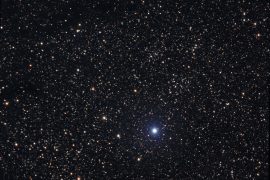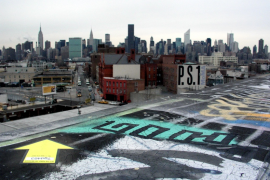What thoughts I have of you tonight, Walt Whitman, for I walked down the sidestreets under the trees with a headache self-conscious looking at the full moon.
In my hungry fatigue, and shopping for images, I went into the neon fruit supermarket, dreaming of your enumerations!
What peaches and what penumbras! Whole families shopping at night! Aisles full of husbands! Wives in the avocados, babies in the tomatoes!—and you, Garcia Lorca, what were you doing down by the watermelons?
Allen Ginsberg, “A Supermarket in California”
One of the biggest questions for the Ambient Literature project has been how these novel works of ubiquitous and technologically-driven literature function as they encounter the really existing conditions of readers’ everyday lives. As literary works that only really exist as they are activated by a reader’s engagement with the text as it functions in concert with the context within which they are experienced, it’s tough to really understand what these works mean without heading out and observing and talking to people as they experience the work under “real” conditions. As Genevieve Bell and Paul Dourish (2006) have noted, however seamless our vision of ubiquitous interactions might be, they remain both “inherently messy” and “inherently heterogeneous” (p. 142) as they come to rely on vast infrastructures subject to local conditions.
For researchers working to understand ambient literature, the challenge of ubiquitous technologies’ heterogeneity is exacerbated in that the function of the works (unlike an instrumentalized ubiquitous system such as might be used for traffic control or healthcare, for instance) comes explicitly in the kinds of thematics or meanings that they are able to elicit. The identification or recognition of such a central thematic for a work of ambient literature is made difficult in that the meaning of a work of ambient literature, as much as it is guided by the author’s orchestration of indeterminacy (see Amy Spencer’s account of this), remains dependent on the variable and heterogenous conditions of the work’s reception.
As we get ready to launch the second of the three commissions of the Ambient Literature project, we’re beginning to get a sense of what these works look like as they are encountered in real situations and the variation that they present. We’ve had a chance to talk to audiences for Duncan Speakman’s It Must Have Been Dark by Then and have been able to try out James Attlee’s The Cartographer’s Confession as we get it ready to debut later this month. With each, it becomes apparent how much the reception of the works comes to be coloured by and depend upon the particular circumstances of its encounter, with these conditions extending beyond the materials created by the author. This is something particularly evident in Duncan’s piece as it invites readers to engage with the work wherever they are and under whatever conditions are at hand: the shape of the piece is different for every participant, both in the way they interact with it and the particular circumstances of their engagement with it. By inviting participants to take an active role in engaging with their contexts, these works are opened up to an almost infinite number of different determinations, contingent upon what audience notice and attend to in their reading of the piece.
Of course, that a literary work depends on the conditions of its reception is nothing new. The basic tenants of a hermeneutic account of literary interpretation relies on a consideration of the background of a work’s reception. From a reader’s own experiences to the manner in which a work engages with the traditions of literature, the meaning of a piece of literature is a situated thing. Extending this kind of thinking beyond just a consideration of literary interpretation, it is possible to recognize such a movement of influence in the experience of life in general. In laying out the way in which our past experiences and prejudices (used here in a neutral sense) contribute to our understanding of the present, Hans-Georg Gadamer (2004) had it that
the horizon of the present is continually in the process of being formed because we are continually having to test all our prejudices. An important part of this testing occurs in encountering the past and in understanding the tradition from which we come. Hence the horizon of the present cannot be formed without the past. There is no more an isolated horizon of the present in itself than there are historical horizons which have to be acquired. Rather, understanding is always the fusion of these horizons supposedly existing by themselves. (p. 305)
For Gadamer, this fusion of horizons lays out a basic account of all human experience. The present is generated by our connections to the past.
For the kinds of situated works we’re concerned with as part of the ambient literature project, it is possible to see this existential hermeneutics at work. However, where these works begin to get interesting is the ways in which they not only leverage the context of their reception toward literary effect, but also the ways in which they enroll even wider contextual networks into their meaningful function. This comes as the work of ambient literature is not only interpreted against a background of a material situation and expressive tradition at the site of its reception, but is itself constituted by such an interaction, previous to the final moment of hermeneutic interpretation, as a heterogeneous amalgam of disparate components. The work itself is a complex thing which depend on wider networks of information, technologies, social practices, infrastructures, and beyond. For the particular kinds of situated literature which is the focus of this project, the specific object of aesthetic appreciation is not simple. They present an aesthetics driven by the wandering attention of the reader, toward and then away from the material of the piece itself.
Aesthetic Networks
So far, each in their own way, these first two commissions highlight the large networks of technologies and practices that are enlisted toward the activation of a work of ambient literature. Less unified monoliths than complex assemblages, these works rely not only on the author’s text and the smartphone applications that help to deliver it, but also upon the wider networks of information communication technology, global positioning systems, transportation infrastructures, architectural forms, local populations, social practices, and any number of other aspects of the world readers might serendipitously come upon as they engage with the work. The meaning that these works create is as dependent on something as simple as having an outlet to charge a phone battery as they are on a happenstance encounter with a person suffering from homelessness while the participant is reading about migration and climate change. Building on established commercial platforms from Google and Apple, they come to even be implicated by networks of global finance as these systems and the kinds of microprocessor fabrication on which they rely are possible only through substantial capital investment. More prosaically, it is possible to say that the sounds of birds singing in the trees, the pace of the water lapping on the Thames, or even the cloud cover affecting the accuracy of GPS all play a role in the development of the aesthetics of the piece.
Even as these works rely on digital technologies for their function, aligning with a certain criteria for writing which is “born digital” to be considered a form of electronic literature (Hayles 2008), they escape the gravity of any specific digital media. If theorizing digital literature can be seen to be founded on a kind of Derridean deferral of the subject made possible by the freedom granted to signification by information networks (think of Sherry Turkle’s (1997) early analysis of the manufacturing of identity in MUDs, for instance), ambient literature, in its dependence on the really-lived conditions of the experience of the work as much as any digital platform, resists this in the reality it bring to bear on the work.
As Alice Bell pointed out in a recent seminar run as part of the Ambient Literature project, works like those addressed in the ambient literature project might fall into a category of post-digital (Cramer 2014) works that present a functional and aesthetic form that has advanced beyond a concern for the digital nature of a work. Instead, what is put forward in this kind of post-digital perspective is the manner in which the digital form folds back onto a reality of non-digital existence, with digital techniques considered alongside a wider consideration of the world. Much like Martin Heidegger’s (1977) ultimately hopefully consideration of technology in his essay “The Question Concerning Technology” in which the challenging forth of technological forms opens the way for a recognition of Being, in the post-digital, these digital forms open the way forward for a re-appreciation of pre-digital forms. In this, responding to a multiplicity of being, works of ambient literature remain unbounded, able to contain multitudes.
Assembling Aesthetics
How should we think about these varied and real components that come together to make these works? Of the satellites, texts, urban spaces, trees, bystanders, and whatever else might be enrolled into the field of attention which drives the work? With their emergent nature, these pieces, in each encounter in concert with a reader, come into being composed of the various aspects that might be at hand in each particular encounter. If there is not a specific point to the object of aesthetic appreciation, what is?
To think of what these works of ambient literature are, it is helpful to think of them not as unified totalities, but as assemblages within which different components (experiences, events, locations, etc.) may be combined. Following Manuel DeLanda (2006) and his working out of Gilles Deleuze’s account of assemblages, to consider this an assemblage “implies that despite the tight integration between its component organs, the relations between them are not logically necessary but only contingently obligatory: a historical result of their close coevolution” (p. 11-12). To put this explicitly, the cellular networks, microprocessors, buildings, pathways, passer bys, and other components of a work of ambient literature are not dependent on each other for their individual being. They all are and all function independently of each other. However, they are all able to be brought together in order to make a whole work.
For Delanda, as these “contingently obligatory” relations within an assemblage are not the product of any kind of logical necessity, it becomes necessary to approach the examination of any such assemblage through empirical investigation, rather than “by thought alone” (p. 11). Each instance needs to be examined for what it is. There is no way to predict what might be found.
While Deleuze saw the “heterogeneity of components an important characteristic of assemblages” (Delanda, 2006, p. 11), Delanda sees the possibility for homogeneous components to play a role in the being of an assemblage. This opens up the possibility of thinking not only of the assemblage of each individual experience of of a work of ambient literature as it is uniquely activated by each individual reader, but also of an assemblage which spans the entire range of experiences, making an assembled whole of the entirety of the work through a systematic process of the empirical investigation of individual experiences.
Approaching these works as assemblages as understood by DeLanda goes beyond a more art-historical consideration of the more static assemblages of Robert Rauschenberg or Joe Brainard. DeLanda’s account of assemblages opens up the possibility for a dynamic consideration of these assemblages as we trace not only their “finished” form, but also the pathways by which they come to be constituted. These are works which come in and out of being with each particular encounter by the audience. They appear almost as performances, with audiences needing to be ushered into them through careful architecting of the experience. In Delanda’s use of Deleuze’s terms, these processes of territorialization and deterritorialization are those that provide the background to the work which would then be subject to any hermeneutic interpretation such as given by Gadamer.
This realist ontology of assemblages speaks to the question of how to understand the products of the ambient literature project as they exist within a wider world. Even as they bring together disparate elements toward an emergent patterning activated by the attention of a reader, they are (ontologically-speaking) not necessarily themselves emergent. They are able to be thought of as really-existent things, both in each unique individual experience and the wider account of their effect as a whole — this while avoiding the need for any transcendental kernel to be given to the work. The aesthetic effect of each work is a complex multitude, with the ultimate question of the function of such aesthetics coming in the appellation of a virtual field rather than singular object. That is, any understanding of these works relies on understanding how to adequately delineate the bounds of any work of attentive individuation on the part of the reader. The work of the researcher is not just to analyze the works, but to come to understand where they begin and where they end.
—Michael Marcinkowski
References
Bell, Genevieve, and Paul Dourish. 2006. “Yesterday’s Tomorrows: Notes on Ubiquitous Computing’s Dominant Vision.” Personal and Ubiquitous Computing 11 (2): 133–43. doi:10.1007/s00779-006-0071-x.
Cramer, Florian. 2014. “What Is ‘Post-Digital’?” A Peer Reviewed Journal About. http://www.aprja.net/what-is-post-digital/.
DeLanda, Manuel. 2006. A New Philosophy of Society: Assemblage Theory and Social Complexity. Bloomsbury.
Gadamer, Hans-Georg. 2004. Truth and Method. Translated by Joel Weinsheimer and Donald G. Marshall. Second, re. London: Continuum International Publishing Group.
Hayles, N. Katherine. 2008. Electronic Literature: New Horizons for the Literary. Notre Dame, IN: University of Notre Dame Press.
Heidegger, Martin. 1977. The Question Concerning Technology and Other Essays. New York, New York, USA: Harper & Row.
Turkle, Sherry. 1997. Life on the Screen: Identity in the Age of the Internet. Simon & Schuster.








